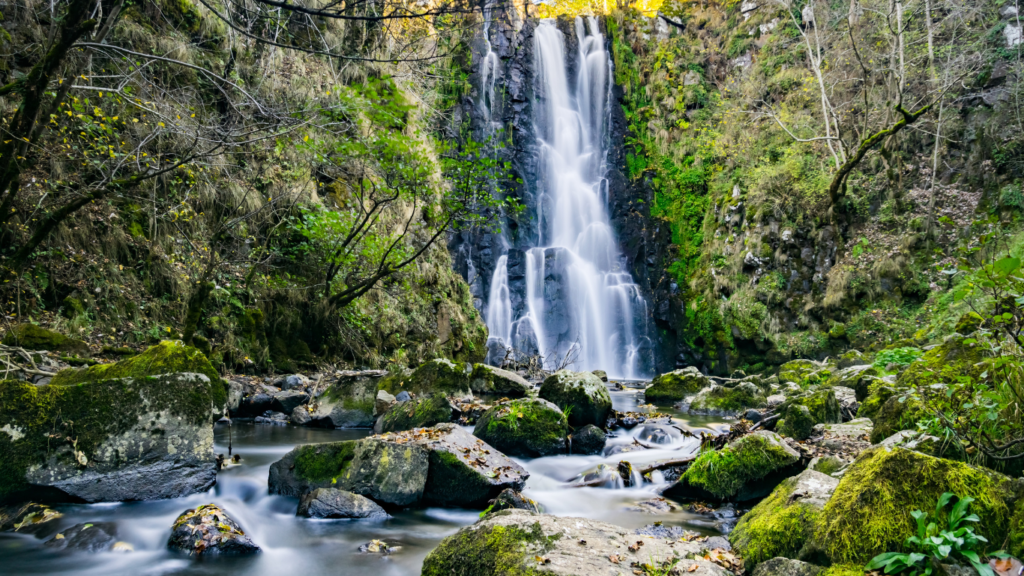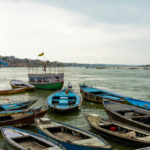Tucked away in the lush embrace of Maharashtra’s Western Ghats, Kumbhe Waterfall is a mesmerizing natural wonder that promises an unforgettable adventure for travelers seeking serenity and thrill. Located in the Mangaon Taluka of Raigad district, this offbeat gem has recently gained fame, partly due to its cinematic appearance in the 2023 South Indian blockbuster Varisu starring Vijay. With its dramatic 178–300-foot cascade, misty surroundings, and rugged charm, Kumbhe Waterfall is a must-visit for nature lovers, trekkers, and road-trip enthusiasts. This blog explores deep into everything you need to know about Kumbhe Waterfall—from how to get there and the best time to visit to activities, safety tips, and nearby attractions.
Discovering Kumbhe Waterfall: A Traveler’s Paradise
Imagine standing atop a cliff, enveloped by clouds, as a thunderous cascade plummets into a turquoise pool below, framed by verdant hills and rocky terrain. That’s Kumbhe Waterfall—a hidden treasure that feels like a scene from a fantasy film. Unlike overcrowded tourist spots, Kumbhe retains an untouched allure, making it perfect for those craving an authentic connection with nature. Its remote location, about 140 km from Mumbai and 110–120 km from Pune, adds to the adventure, with scenic routes like Tamhini Ghat setting the stage for an epic journey.
Kumbhe Waterfall isn’t just about the view; it’s an experience. Whether you’re a solo traveler chasing solitude, a group of friends on a monsoon road trip, or a family seeking a picnic spot, this destination delivers. Its accessibility by vehicle, combined with optional trekking and rappelling opportunities, caters to both casual visitors and adrenaline junkies. Let’s embark on this journey to uncover why Kumbhe Waterfall is Maharashtra’s best-kept secret.
Where is Kumbhe Waterfall?
Kumbhe Waterfall is nestled in Kumbhe village, Mangaon Taluka, Raigad district, Maharashtra. Situated in the Sahyadri mountain range, it’s a pristine spot surrounded by lush greenery and rocky cliffs. The waterfall, also known as Kundalika Waterfall in some accounts, cascades from a height of approximately 178–300 feet, creating a breathtaking spectacle, especially during the monsoon. Its proximity to major cities makes it an ideal weekend getaway:
From Mumbai: Approximately 140–150 km, a 4–5-hour drive via NH66 or Panvel–Pen–Nagothane–Kolad–Kumbhe.
From Pune: Around 110–120 km, a 3–4-hour drive via Pune–Paud–Mulshi–Tamhini Ghat–Nizampur–Kumbhe.
Nearest Railway Station: Mangaon Railway Station, 23–25 km away, accessible by trains from Mumbai or Pune.
Nearest Airport: Chhatrapati Shivaji Maharaj International Airport, Mumbai, about 150 km away.
The waterfall’s remote setting, coupled with its natural beauty, has earned it a 4.7-star rating from over 1,000 Google reviews, with travelers praising its monsoon splendor and serene ambiance.
Best Time to Visit Kumbhe Waterfall
Timing is everything when planning a trip to Kumbhe Waterfall. The monsoon season (June to September) is unanimously recommended by sources like Tripoto and Classy Nomad as the best time to witness the waterfall in its full glory. During these months, heavy rainfall transforms the cascade into a roaring spectacle, with mist rising from the base and the surrounding hills cloaked in vibrant green. The Tamhini Ghat route becomes a visual treat, with clouds drifting low and small streams dotting the landscape.
Peak Monsoon (July–August): Ideal for the most dramatic views and adventure activities like rappelling. However, expect slippery paths and potential road hazards.
Early or Late Monsoon (June, September): Offers milder weather, fewer crowds, and safer trekking conditions while still showcasing the waterfall’s beauty.
Pre/Post-Monsoon (May, October): Suitable for those avoiding heavy rains, though the water flow may be less intense. Sunset views near the waterfall are a bonus, as noted by TripToMeter.
Avoid visiting during the dry season (November–April), as the waterfall may reduce to a trickle, diminishing its charm, according to Tripadvisor reviews of similar waterfalls.
How to Reach Kumbhe Waterfall
Getting to Kumbhe Waterfall is an adventure in itself, with scenic drives and multiple transport options. Here’s a detailed breakdown:
By Car (Recommended)
Driving is the most convenient and popular way to reach Kumbhe, offering flexibility and stunning views. From Mumbai, take the NH66 route via Panvel–Pen–Nagothane–Kolad–Kumbhe, covering 145–165 km in 4–5 hours. From Pune, follow the Pune–Paud–Mulshi–Tamhini Ghat–Nizampur–Kumbhe route, spanning 110–120 km in 3–4 hours. Key tips:
Navigation: Use Google Maps and set “Kumbhe Waterfall” as your destination. The final stretch involves narrow, winding roads, so drive cautiously.
Road Conditions: The Tamhini Ghat section is scenic but prone to landslides during heavy rains. Check weather updates and avoid the Kolad route, which some travelers (e.g., Varad Prasad) report as rough.
Parking: Ample parking is available near the top viewpoint, where your vehicle reaches the waterfall’s edge.
By Public Transport
Public transport is less convenient due to the waterfall’s remote location, but it’s feasible:
Train: Take a train from Mumbai or Pune to Mangaon Railway Station (23–25 km from the waterfall). From Mumbai, the Panvel–Mangaon train is a good option. From the station, hire an auto-rickshaw (INR 400–600) or take a local bus to Kumbhe village.
Bus: Board a state transport or private bus to Mangaon Bus Stand from Mumbai or Pune. From Mangaon, take a taxi or shared rickshaw to Kumbhe village, followed by a short walk to the waterfall. Direct buses to Kumbhe are rare, so plan for transfers.
Travel Time: Expect 5–6 hours from Mumbai or 4–5 hours from Pune, including transfers.
By Bike
For thrill-seekers, a bike ride to Kumbhe is exhilarating, as shared by Tripoto’s biking group. The 60–70 km/h ride through Tamhini Ghat offers stunning views but demands caution due to slippery roads and narrow stretches. Ensure your bike has good traction and carry rain gear during the monsoon.
Kumbhe Tunnel: A Unique Highlight
A standout feature of the journey is the 200-meter Kumbhe Tunnel, a dark, narrow passage that adds a dash of mystery. Emerging from the tunnel, you’re greeted by the sound of rushing water and a glimpse of the waterfall’s top. Bikers and drivers alike rave about this moment, with TripToMeter calling it a “memorable experience.” Stop for photos just outside the tunnel, but avoid lingering inside due to limited visibility.
Exploring Kumbhe Waterfall: Viewpoints and Activities
Kumbhe Waterfall offers three distinct viewpoints, each providing a unique perspective, as highlighted by TheFreeBird.net and In My Eye.
1. Top Viewpoint
Your vehicle takes you directly to the top of the waterfall, making it accessible for all travelers, including families and beginners. From here, you see the water streaming from a small creek into the valley below, surrounded by misty hills. This spot is perfect for:
Picnicking: The flat area is ideal for a relaxed picnic, though no food stalls are available, so pack essentials from Nizampur or Mangaon.
Photography: Capture the misty valley and cloud-draped hills, especially during early morning visits when light is soft.
Relaxation: The soothing sound of water and serene ambiance make it a great spot to unwind.
Time Required: 5–10 minutes. Difficulty: None—accessible by vehicle.
2. Waterfall Viewpoint
A 1-km drive or 15-minute walk from the top viewpoint brings you to the Waterfall Viewpoint, offering a frontal view of the cascade. This is the most photographed spot, showcasing the waterfall’s full grandeur as it plunges into a turquoise pool. Highlights include:
Photography: Ideal for Instagram-worthy shots, with drone footage (as seen on Tripoto) revealing the waterfall’s scale.
Sightseeing: The lush greenery and rocky cliffs create a cinematic backdrop.
Group Fun: Popular with friends and families for its easy access and stunning views.
Time Required: 30–60 minutes, including travel and exploration. Difficulty: Easy, suitable for all ages.
3. Dome/Ridge Viewpoint
For adventure seekers, the Dome or Ridge Viewpoint (popularized by Varisu) offers a closer, more exhilarating perspective. Reached by a 90-minute round-trip trek, this route is challenging and risky, as noted by TheFreeBird.net.
Trekking: Two routes lead to the Dome: a red route with loose rocks and slippery waterfall-like conditions, and an orange route, slightly less hazardous but still demanding. Only experienced trekkers should attempt this, wearing high-traction footwear.
Rappelling: Organized by groups like Maharashtra Desha Adventure, rappelling down the 300-foot cascade is a thrilling option. Professional guides provide safety gear and instruction, with sessions from 8:00 AM to 2:00 PM.
Views: The Dome offers a dramatic close-up of the waterfall, with mist and roaring water creating an adrenaline-pumping experience.
Time Required: 90–120 minutes for trekking; 3–4 hours for rappelling.
Difficulty: Difficult, recommended for fit and experienced adventurers only.
Safety Note: A tragic incident in 2024 involving a 26-year-old travel influencer underscored the dangers of the Dome route. Always trek with a guide, avoid risky areas, and check weather conditions, as heavy rain increases slipperiness.
Activities at Kumbhe Waterfall
Kumbhe offers a range of activities to suit different travel styles:
Trekking and Hiking: The Dome route is a highlight for trekkers, while the short walk to the Waterfall Viewpoint suits beginners. The surrounding Sahyadris offer additional trails for exploration.
Rappelling: A 380-foot descent through the waterfall’s gush is a bucket-list adventure, organized by groups like Mi Durg Veda. Basic fitness and professional guidance are required.
Photography: From misty top views to dramatic frontal shots, Kumbhe is a photographer’s paradise. Early mornings offer the best light and fewer crowds.
Picnicking: The top viewpoint is ideal for a family picnic, with space to relax and enjoy packed meals.
Road Tripping: The journey through Tamhini Ghat, with its winding roads and cloud-covered hills, is a highlight for bikers and drivers.
Nature Observation: The waterfall’s surroundings are rich with flora and fauna, making it a haven for nature lovers. Keep an eye out for small streams and seasonal wildflowers.
Note: Swimming at the base is restricted due to safety concerns and inaccessibility, unlike some other waterfalls like Devkund.
Safety Tips for Visiting Kumbhe Waterfall
Safety is paramount, especially during the monsoon when paths are slippery and water flow is intense. Here are essential tips, inspired by Classy Nomad and CityBit.in:
Trek with Care: Stick to marked trails, especially for the Dome route. Avoid trekking alone and hire a local guide for risky paths.
Wear Proper Footwear: High-traction shoes are a must to prevent slips on wet rocks and grass.
Check Weather: Avoid visiting during heavy rain due to landslide risks and increased water flow, which can make rappelling dangerous.
Stay Hydrated and Fueled: No food or water stalls are available at the waterfall, so carry sufficient supplies from Nizampur or Mangaon.
Inform Others: Share your travel plans and expected return time with family or friends, as mobile connectivity may be spotty.
Respect Nature: Avoid littering and follow the “leave no trace” principle to preserve Kumbhe’s pristine beauty.
Rappelling Safety: Use certified operators, wear provided safety gear (helmets, harnesses), and follow instructors’ guidance.
Avoid Risky Areas: Steer clear of the waterfall’s edge or unmarked paths, especially at the Dome, where accidents have occurred.
Entry Fees and Opening Hours
Entry Fee: Kumbhe Waterfall is free to visit, with no formal ticket required, making it accessible for all travelers.
Opening Hours: The waterfall is open 24 hours, but daylight visits (6:00 AM–6:00 PM) are recommended for safety and optimal views. Morning arrivals allow ample time to explore.
Note: Rappelling or guided tours may incur fees (e.g., INR 1,500–2,500 per person), depending on the operator. Check with providers like Treks and Trails India for pricing.
Nearby Attractions to Enhance Your Trip
Kumbhe Waterfall pairs perfectly with other attractions in Raigad, creating a fulfilling day trip or weekend itinerary. Here are top picks:
Raigad Fort (35 km, 1 hour): A historic hill fort at 820 meters, offering panoramic views of the Sahyadris. Trek to viewpoints like Bhavani Tok or Takmak Tok for cloud-covered vistas during the monsoon.
Nanemachi Waterfall (34 km via Khadsamble–Muthavali Rd): Another stunning cascade, ideal for those combining multiple waterfall visits in a day. Its clear pool and green surroundings are perfect for photography.
Devkund Waterfall (approx. 50 km): A popular trek destination with a serene pool, though it requires a longer hike than Kumbhe.
Harihareshwar Temple (70 km): A spiritual site by the Arabian Sea, known for its black sand beach and tranquil vibes.
Mangad Fort (40 km): A lesser-known fort offering historical exploration and scenic views.
Suvarna Ganesh Temple, Shrivardhan (80 km): A unique temple housing a golden Ganesh idol, blending spirituality with coastal charm.
Bhimashankar Temple (120 km): A Jyotirlinga shrine amidst lush forests, ideal for spiritual travelers.
These attractions, accessible by car or taxi, add variety to your Kumbhe adventure, blending nature, history, and culture.
Where to Stay Near Kumbhe Waterfall
Kumbhe village lacks formal accommodations, but nearby Mangaon and surrounding areas offer options for overnight stays:
Hotels in Mangaon (25 km): Budget and mid-range hotels like Hotel Sai Krupa or MTDC Resort Mangaon provide comfortable stays with basic amenities. Expect rates of INR 1,500–3,000 per night.
Homestays in Raigad: Platforms like Airbnb offer homestays near Tamhini Ghat or Kolad, ideal for a rustic experience. Prices range from INR 2,000–5,000 per night.
Resorts in Kolad (40 km): For luxury, try resorts like Kundalika Cottages or Rivergate Resort, offering river views and adventure activities like rafting. Rates start at INR 4,000 per night.
Camping: Some tour operators (e.g., Maharashtra Desha) offer camping near Kumbhe or Nanemachi, with tents and basic facilities. Check availability in advance.
Tip: Book accommodations early during the monsoon season, as demand spikes. Day trips from Mumbai or Pune are common, eliminating the need for overnight stays.
What to Pack and Prepare
To ensure a smooth trip, pack these essentials, inspired by Treks and Trails India and Varad Prasad:
Clothing: Lightweight, quick-dry clothes, raincoats or ponchos, and high-traction trekking shoes. Carry an extra set for post-trek comfort.
Food and Water: Pack snacks, packed meals, and at least 2 liters of water per person, as no stalls are available at the waterfall.
Safety Gear: A first-aid kit, flashlight (for the tunnel), and insect repellent for the humid monsoon environment.
Trekking Gear: For the Dome route, bring a backpack, gloves, and a trekking pole for stability.
Photography Equipment: A waterproof camera or phone case to capture the misty views without damage.
Documents: Carry ID proof and a screenshot of your rappelling/tour booking confirmation, if applicable.
Miscellaneous: Sunglasses, a hat, and sunscreen for sun protection, especially in September.
Note: Leave valuables at home or secure them in your vehicle, as there are no lockers at the waterfall.
Local Culture and Significance
Kumbhe Waterfall holds cultural and spiritual significance for local communities. The region around Kumbhe village has been home to tribal groups living in harmony with nature for centuries. The waterfall, named after the village (derived from “Kumbh,” meaning an earthen water vessel), symbolizes nature’s abundance, with water flowing like a gift from the Sahyadris.
Locals often visit during festivals or holidays, treating the waterfall as a picnic spot. Its cinematic fame, courtesy of Varisu, has made it a point of pride, with villagers welcoming travelers while urging respect for the environment. The area’s spiritual vibe is enhanced by nearby sites like Harihareshwar Temple and Raigad Fort, steeped in Maratha history.
Practical Tips for a Memorable Visit
Arrive Early: Start your journey by 4:00–5:00 AM from Mumbai or Pune to reach by 8:00–9:00 AM, avoiding crowds and enjoying soft morning light.
Join a Tour: For first-timers or rappelling enthusiasts, book a guided tour with operators like Treks and Trails India or Mi Durg Veda. They provide transport, guides, and safety gear.
Check Road Conditions: Monsoon rains can cause landslides or road closures on Tamhini Ghat. Follow local news or contact Mangaon authorities for updates.
Travel Light: Carry only essentials to ease trekking and exploration, especially for the Dome route.
Capture Responsibly: Avoid risky selfie spots near cliffs or the waterfall’s edge, as accidents have occurred.
Connect with Locals: Engage with villagers in Kumbhe or Mangaon for tips on hidden viewpoints or seasonal events.
Plan a Combo Trip: Pair Kumbhe with Nanemachi Waterfall or Raigad Fort for a full day of exploration.
Why Kumbhe Waterfall Should Be on Your Travel List
Kumbhe Waterfall is more than a destination; it’s a journey into nature’s heart. Its accessibility makes it welcoming for families and beginners, while the Dome trek and rappelling cater to adventure seekers. The scenic drive, misty tunnel, and cascading waters create a sensory feast, leaving you with memories to cherish. Unlike commercialized spots, Kumbhe’s offbeat charm offers tranquility and authenticity, as echoed in Tripoto’s reviews.
Whether you’re chasing Instagram-worthy shots, seeking a spiritual retreat, or craving an adrenaline rush, Kumbhe delivers. Its growing popularity, fueled by social media and cinema, means now is the time to visit before it becomes mainstream. Pack your bags, hit the road, and let Kumbhe Waterfall weave its magic.
Conclusion: Plan Your Kumbhe Waterfall Adventure
Kumbhe Waterfall is a testament to Maharashtra’s natural splendor, blending accessibility, adventure, and serenity. From the easy-to-reach top viewpoint to the thrilling Dome trek, it caters to every traveler’s spirit. The monsoon season transforms it into a spectacle, with Tamhini Ghat’s misty roads and the Kumbhe Tunnel adding to the allure. By planning your visit with safety, preparation, and respect for nature, you’ll unlock an experience that’s both exhilarating and soul-soothing.
Ready to explore? Set your GPS to Kumbhe Waterfall, pack your monsoon essentials, and embark on a journey to one of Maharashtra’s finest hidden gems.



